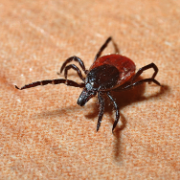Closing the Knowledge Gap Between Lyme and Other Diseases

Did you know that you can have Lyme disease without testing positive? Or that Lyme Disease symptoms can often mimic other conditions?
It turns out that this is especially true if you live with chronic illness. Inconsistencies in testing methods have made this debilitating disease notoriously difficult to diagnosis, and this can leave patients suffering for years without proper treatment.
A recent study led by Dr. Melanie Wills, head of the G. Magnotta Lyme Disease Research Lab in the Department of Molecular and Cellular Biology, sheds new light on the presentation of the disease beyond test results, helping to close an important knowledge gap.
“Our aim was really to bridge the ‘bench to bed’ gap in chronic illness, including Lyme disease,” says Wills, who established the research lab in 2017 to meet a need for further research into the microbiology behind the Borrelia bacterial complex that causes Lyme disease, and is transmitted via tick bite.
 Wills and her team examined blood samples from 157 different healthy and complexly ill patients in Atlantic Canada. They found that nearly 10 percent were positive for exposure to Borrelia – a staggering difference from previous studies that found a positivity rate of less than one percent in the healthy Canadian Maritimes population.
Wills and her team examined blood samples from 157 different healthy and complexly ill patients in Atlantic Canada. They found that nearly 10 percent were positive for exposure to Borrelia – a staggering difference from previous studies that found a positivity rate of less than one percent in the healthy Canadian Maritimes population.
The team also found a major overlap in symptoms of Lyme disease and other chronic diseases among the study cohort. Some participants who entered the study with non-Lyme diagnoses such as fibromyalgia showed evidence of Borrelia exposure. This was particularly true among individuals who never developed a bull’s-eye rash, the classic characteristic of early-stage Lyme infection.
Disturbingly, the researchers also found that the current testing protocol is less effective than previously thought. The current method is a “two-tier” test, where two different techniques are jointly used to confirm if a blood sample contains the antibodies that indicate past exposure to Borrelia. While previous studies found that the results of the two different testing methods aligned roughly 60% of the time, Wills’ study showed it to be closer to 25%.
So what’s next for the research team as they tackle this challenging disease?
“Testing for antibodies can be useful as a surveillance tool but, for diagnostic purposes, better tools are needed,” says Wills.
Developing a more accurate diagnostic method is a major focus of the G. Magnotta Lab, and Wills and her team are working on a new approach that relies on direct detection of the pathogen itself, rather than antibodies.
“The current study underscores how difficult it is to identify Lyme disease based on clinical presentation or conventional testing. Better diagnostic tools will not only allow us to improve patient outcomes, but also how we monitor and manage the disease at the population level.”
This study was funded by the G. Magnotta Foundation for Vector-Borne Diseases, the McCain Foundation, and the Rotary of Woodstock in New Brunswick.
Read the full study in the journal PloS One and a summary of the research on the G. Magnotta Research Lab website.
Read about other CBS Research Highlights.